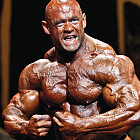 There was a time when the fans of pro bodybuilding were nearly all people who lived the bodybuilding lifestyle. That was the so-called golden era that stretched from the reign of Arnold in the ’70s and lasted throughout the ’80s, when symmetry, shape and proportion were equally as important as size.
There was a time when the fans of pro bodybuilding were nearly all people who lived the bodybuilding lifestyle. That was the so-called golden era that stretched from the reign of Arnold in the ’70s and lasted throughout the ’80s, when symmetry, shape and proportion were equally as important as size.
As the ’90s dawned, we began to see a new type of physique—thicker, denser, and more Herculean. Men like Dorian Yates, Nasser El Sonbaty and Paul Dillett helped usher in a new standard of immensity. Once the genie was out of the bottle, we were never able to squeeze it back in. Freak became a complimentary word, exemplified in the years that followed by physiques like those of Ronnie Coleman, Jay Cutler and Markus Ruhl. Men who had held the Mr. Olympia title like Frank Zane and Chris Dickerson were now considered “tiny” and would not have been able to place in the top five in this new era.
As you might expect, the fans who favored a more aesthetic look drifted away over the years—feeling the sport of competitive bodybuilding had gone down a road they had no interest in traveling. When you stop and think about it, however, who’s to say that the bigger physiques are necessarily the better ones? Bodybuilding is judged totally on opinion. The qualities that are considered when the best total package is determined include not only mass but also shape, structure, symmetry, proportion and condition.
In just this year alone I’ve seen three cases that got me thinking hard about who really decides what is the “best physique” in a given contest. Before I start, understand that I am able to separate physiques from the people inside them. There have been men who had incredible physiques but were not much in the human being department, in my opinion, and I’ve known some great people whose physiques I could pick apart all day.
In terms of the situations that got me thinking, the first was the ’12 Arnold Classic, in which Branch Warren beat Dennis Wolf. I like both guys quite a bit, having gotten to know them over the years, but I happen to like Wolf’s physique better. His shape and structure are just breathtaking, and he does carry plenty of mass. Branch is a hell of a guy too. He beat Dennis because he carried more mass on a shorter frame, was in slightly better condition and beat Wolf on hamstrings, calves and lower lats. That was the way the judges saw it. Many fans didn’t see it the same way. Who is to say that what they prefer is wrong and the judges are right?
The next two cases occurred a couple of months later at the New York Pro. First, in the 212 division I saw the IFBB debut of Sami Al Haddad from Bahrain, one of the most aesthetically pleasing bodies I have ever seen on a contest stage. His muscle bellies were round and billowing, more like what you would see in an idealized sculpture than an actual person, but Sami was beaten by Kevin English, whose only advantage at all was that he was more massive. In the open division we did see a retro physique come out on top. At 6’2” and 270 with a 30-inch waist, Cedric McMillan gave many in the audience flashbacks to old-school champs like Arnold and Lee Haney—physiques that were rugged yet still athletic looking and—dare I say it without my own masculinity being questioned?—just beautiful to behold. Immediately there was speculation as to how he would fare at the Mr. Olympia. The consensus seemed to be that he would be very lucky to break the top six unless he packed on more size and showed up with deeper-etched grooves in his glutes. To me, that’s a damn shame.
Cedric has the type of look that draws people into the sport, just as Arnold’s look did a generation ago. It’s a safe bet that more guys would aspire to his type of build over a Branch or a Jay, men so bulky and thick that it’s hard to imagine they can even walk. Again, that’s not a knock on them or even the judges—just an observation on what might help bring more people into the sport I have loved for most of my life.
The standard now may call for inhuman, outrageous, almost cartoonish bulk, but that doesn’t mean the standard can’t shift again. And unless we are happy with our sport’s remaining essentially a small hardcore cult and happy about the number of bodybuilders who have zero interest in competitive bodybuilding, the ideals need to change. Who is to say what the ideal is? You! Don’t assume you have no voice. Without fans, there would be no sport. Volunteer to be a test judge at local and regional shows. If more and more judges put the emphasis on aesthetics and shape, those types of physiques would gain in prominence.
What about the pros, you ask? Where do you think the pros come from? They all began as amateurs. If you love the sport as I do, and if you want to see things change, walking away or even complaining isn’t going to make a difference. It’s up to us to help steer the sport of bodybuilding back on track so it can once again be something more people take an interest in and want to be part of.
Editor’s note: Ron Harris is the author of Real Bodybuilding—Muscle Truth From 25 Years In the Trenches, available at www.RonHarrisMuscle.com.




















You must be logged in to post a comment Login